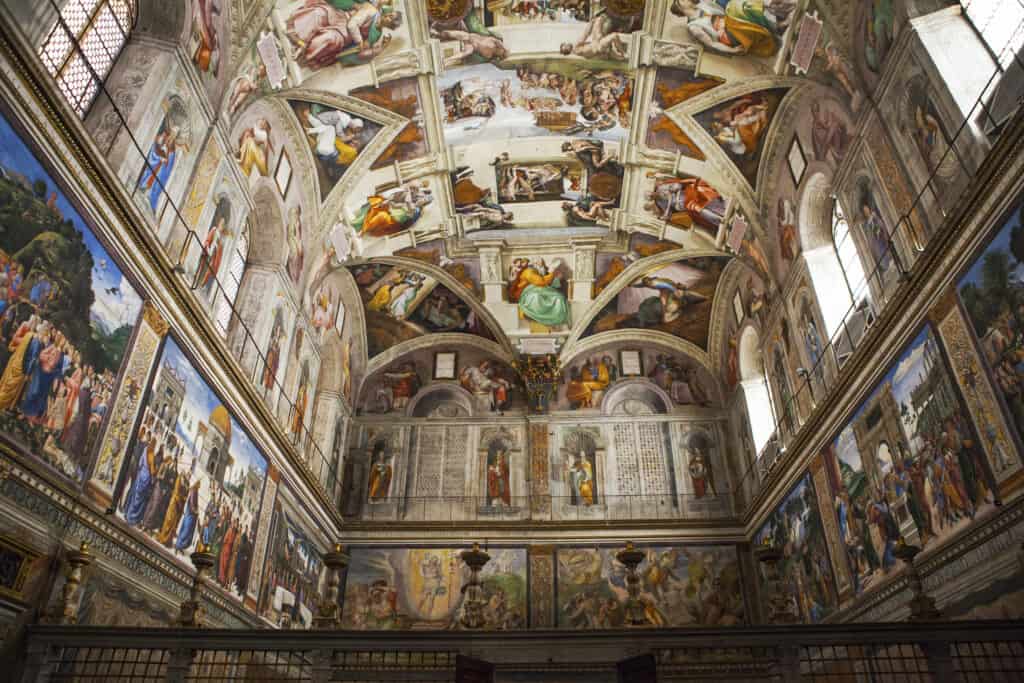Back in 1508 CE, the Pope commissioned the famous Florentine painter and sculptor Michelangelo, and now an incredibly famous historic artist today, to paint the Sistene Chapel. The Sistine Chapel is one of the most revered works of art on the planet, but it does have people wondering a few things. The most common question is whether or not Michelangelo did all the painting work himself.
Michelangelo did all the painting of the Sistine Chapel himself, by hand, over the course of several years. He did have assistants to help set up scaffolding and transferring his paints, but the actual painting work was only done by the artist himself.

To learn more about the exciting history of the painting of the Sistine Chapel, the process behind creating such a wondrous work of art, and how it all came about, keep on reading!
Where It All Began
The Sistine Chapel is a part of a building complex in Rome within the Vatican City, a place which many people call the center of Christianity in the world, which dates all the way back to Ancient Roman times. The construction of the building was finished in 1481 CE, but just twenty years later, in 1504 CE, a huge crack appeared in the ceiling.
The building had already been built in a truly magnificent and impressive way and contained a ton of artistic additions and carvings. However, repairing the crack that appeared was a chance to take this one step further.
The walls of the Sistine Chapel were already covered in beautiful Christian artwork, depicting characters like Jesus and Moses, which had been added to the building by legendary artists like Pietro Perugino and Sandro Botticelli. The pope wanted something different.
At the time, Michelangelo was already having his praising sung across the country of Italy, and indeed most of Europe. His famous piece, the massive Statue of David, was already displayed and out in the public eye in his hometown of Florence, and everyone loved what he did.
The Pope at the time, Pope Julius II, was adamant that Michelangelo was the right man for the job. We’re sure you’ll agree that what he’s achieved is like nothing else on the planet.
The Rough Journey
At the time, the Pope and Michelangelo were already working together on creating an artistic tomb for the Pope, but things weren’t going well. The project for designed the Pope’s tomb had started around March of the year 1505, but the artists and councils weren’t happy.
Over 40 marble statues had been commissioned, but the designs of which were highly contested. The contracts were written and rewritten over and over again, the designs becoming more average and generic every time. Eventually, the original date that the work was supposed to be completed by had flown past,
Michelangelo was so stressed by the work that he described the project as ‘the tragedy of the tomb,’ and even left Rome, claiming his sculpting students would later finish the job.
With all this in mind, it’s easy to see why Michelangelo didn’t want to work with the Pope on a new project, but eventually, in May 1508, he accepted the most ambitious project yet—painting the roof of the Sistine Chapel.
The project contract stated that Michelangelo was to paint over the current sky and stars painting that existed on the roof already with images of the 12 apostles on the sides of the roof. The middle of the roof was supposed to have some kind of architectural design in place.
However, in true Michelangelo fashion, he scrapped the plans and instead went on to design something far more spectacular.
Creating Something Beautiful
Michelangelo planned to cover all 800 square meters with a completely beautiful design that was unlike anything the world had ever seen. Over the following four years, Michelangelo set to work.
The vast majority of the work was completed by hand, meaning if you go and see the Sistine Chapel for yourself today, every piece of artwork and painting you see on the roof of the building was all done by one man.
Michelangelo did start with a few assistants, but he quickly realized that the actual painting part of the work could only ever be done by him. These assistants instead helped him with the logistics of the work, managing and erecting scaffolding and repositioning where he needed to be.
Nevertheless, Michelangelo was incredibly private about the project, and nobody outside of this group of workers was allowed to see the designs until they were finished. Not even the Pope was allowed, who may have been the most impatient of them all.
Finally, the designs were finished and were gifted to the world and human history, and remain on the roof of the Sistine chapel to this day. When you consider how long ago these paintings were made, it’s incredible that Michelangelo was able to achieve what he did, and it’s truly something you can be sure will never grace the Earth again.